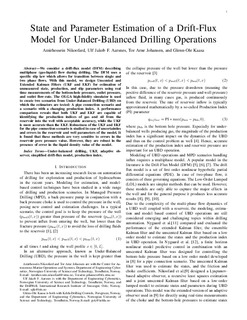| dc.contributor.author | Nikoofard, Amirhossein | |
| dc.contributor.author | Aarsnes, Ulf Jakob Flø | |
| dc.contributor.author | Johansen, Tor Arne | |
| dc.contributor.author | Kaasa, Glenn-Ole | |
| dc.date.accessioned | 2017-12-13T11:47:44Z | |
| dc.date.available | 2017-12-13T11:47:44Z | |
| dc.date.created | 2017-11-24T15:54:30Z | |
| dc.date.issued | 2017 | |
| dc.identifier.citation | IEEE Transactions on Control Systems Technology. 2017, 25 (6), 2000-2009. | nb_NO |
| dc.identifier.issn | 1063-6536 | |
| dc.identifier.uri | http://hdl.handle.net/11250/2471112 | |
| dc.description.abstract | We consider a drift-flux model (DFM) describing multiphase (gas-liquid) flow during drilling. The DFM uses a specific slip law, which allows for transition between single and two phase flows. With this model, we design unscented Kalman filter (UKF) and extended Kalman filter (EKF) for the estimation of unmeasured state, production, and slip parameters using real-time measurements of the bottom-hole pressure, outlet pressure, and outlet flow rate. The OLGA high-fidelity simulator is used to create two scenarios from underbalanced drilling on which the estimators are tested: a pipe connection scenario and a scenario with a changing production index (PI). A performance comparison reveals that both UKF and EKF are capable of identifying the PIs of gas and oil from the reservoir into the well with acceptable accuracy, while the UKF is more accurate than the EKF. Robustness of the UKF and EKF for the pipe connection scenario is studied in case of uncertainties and errors in the reservoir and well parameters of the model. It is found that these methods are very sensitive to errors in the reservoir pore pressure value. However, they are robust in the presence of error in the liquid density value of the model. | nb_NO |
| dc.language.iso | eng | nb_NO |
| dc.publisher | Institute of Electrical and Electronics Engineers (IEEE) | nb_NO |
| dc.title | State and Parameter Estimation of a Drift-Flux Model for Underbalanced Drilling Operations | nb_NO |
| dc.type | Journal article | nb_NO |
| dc.type | Peer reviewed | nb_NO |
| dc.description.version | acceptedVersion | nb_NO |
| dc.source.pagenumber | 2000-2009 | nb_NO |
| dc.source.volume | 25 | nb_NO |
| dc.source.journal | IEEE Transactions on Control Systems Technology | nb_NO |
| dc.source.issue | 6 | nb_NO |
| dc.identifier.doi | 10.1109/TCST.2016.2638683 | |
| dc.identifier.cristin | 1518247 | |
| dc.relation.project | Norges forskningsråd: 210432 | nb_NO |
| dc.relation.project | Norges forskningsråd: 203525 | nb_NO |
| dc.relation.project | Norges forskningsråd: 223254 | nb_NO |
| dc.description.localcode | © 2017 IEEE. Personal use of this material is permitted. Permission from IEEE must be obtained for all other uses, in any current or future media, including reprinting/republishing this material for advertising or promotional purposes, creating new collective works, for resale or redistribution to servers or lists, or reuse of any copyrighted component of this work in other works. | nb_NO |
| cristin.unitcode | 194,63,25,0 | |
| cristin.unitname | Institutt for teknisk kybernetikk | |
| cristin.ispublished | true | |
| cristin.fulltext | postprint | |
| cristin.qualitycode | 2 | |
